广东版开心英语六年级上册全册教案
六年级上册英语教案-Unit 1Feeling sick 第二课时 广东开心英语(粤人版)
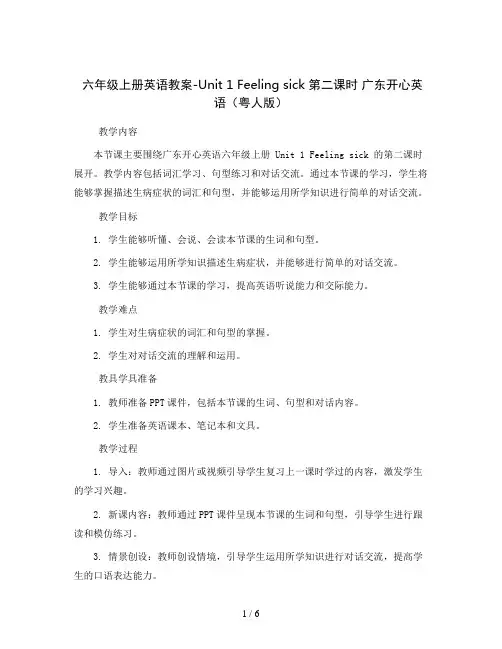
六年级上册英语教案-Unit 1 Feeling sick 第二课时广东开心英语(粤人版)教学内容本节课主要围绕广东开心英语六年级上册 Unit 1 Feeling sick 的第二课时展开。
教学内容包括词汇学习、句型练习和对话交流。
通过本节课的学习,学生将能够掌握描述生病症状的词汇和句型,并能够运用所学知识进行简单的对话交流。
教学目标1. 学生能够听懂、会说、会读本节课的生词和句型。
2. 学生能够运用所学知识描述生病症状,并能够进行简单的对话交流。
3. 学生能够通过本节课的学习,提高英语听说能力和交际能力。
教学难点1. 学生对生病症状的词汇和句型的掌握。
2. 学生对对话交流的理解和运用。
教具学具准备1. 教师准备PPT课件,包括本节课的生词、句型和对话内容。
2. 学生准备英语课本、笔记本和文具。
教学过程1. 导入:教师通过图片或视频引导学生复习上一课时学过的内容,激发学生的学习兴趣。
2. 新课内容:教师通过PPT课件呈现本节课的生词和句型,引导学生进行跟读和模仿练习。
3. 情景创设:教师创设情境,引导学生运用所学知识进行对话交流,提高学生的口语表达能力。
4. 小组活动:学生分组进行角色扮演,练习本节课的对话内容,巩固所学知识。
5. 巩固练习:教师设计一些练习题,帮助学生巩固本节课所学知识。
6. 总结:教师对本节课所学内容进行总结,强调重点和难点。
板书设计1. 教师在黑板上列出本节课的生词和句型,并标注重点和难点。
2. 教师在黑板上展示本节课的对话内容,方便学生参考和模仿。
作业设计1. 学生完成课后的练习题,巩固本节课所学知识。
2. 学生根据本节课的对话内容,编写一个类似的对话,并和同学进行练习。
课后反思本节课通过PPT课件、情景创设和小组活动等教学手段,帮助学生掌握了描述生病症状的词汇和句型,并能够进行简单的对话交流。
在教学过程中,教师要注意关注学生的学习情况,及时解答学生的疑问,确保学生能够掌握所学知识。
六年级上册英语教案-Unit 4 Keeping Clean 第一课时 广东开心英语
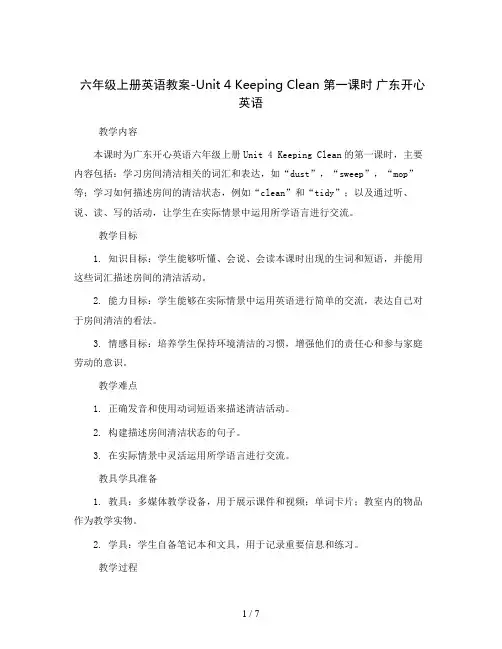
六年级上册英语教案-Unit 4 Keeping Clean 第一课时广东开心英语教学内容本课时为广东开心英语六年级上册Unit 4 Keeping Clean的第一课时,主要内容包括:学习房间清洁相关的词汇和表达,如“dust”,“sweep”,“mop”等;学习如何描述房间的清洁状态,例如“clean”和“tidy”;以及通过听、说、读、写的活动,让学生在实际情景中运用所学语言进行交流。
教学目标1. 知识目标:学生能够听懂、会说、会读本课时出现的生词和短语,并能用这些词汇描述房间的清洁活动。
2. 能力目标:学生能够在实际情景中运用英语进行简单的交流,表达自己对于房间清洁的看法。
3. 情感目标:培养学生保持环境清洁的习惯,增强他们的责任心和参与家庭劳动的意识。
教学难点1. 正确发音和使用动词短语来描述清洁活动。
2. 构建描述房间清洁状态的句子。
3. 在实际情景中灵活运用所学语言进行交流。
教具学具准备1. 教具:多媒体教学设备,用于展示课件和视频;单词卡片;教室内的物品作为教学实物。
2. 学具:学生自备笔记本和文具,用于记录重要信息和练习。
教学过程1. 导入:通过展示一些整洁和杂乱的房间图片,引发学生对于房间清洁的讨论,激发学习兴趣。
2. 新授:介绍本课时的新词汇和短语,通过图片和动作演示帮助学生理解和记忆。
3. 实践:进行小组活动,让学生模拟清洁房间的场景,用英语描述他们正在做的事情。
4. 巩固:通过听力和阅读练习,让学生在实际语境中进一步理解和运用所学知识。
5. 总结:回顾本课时的重点内容,确保学生对新知识有清晰的认识。
板书设计板书将清晰地展示本课时的重点词汇、短语和主要句型,通过颜色和图表等辅助手段,使内容更加直观易懂。
作业设计1. 书面作业:完成课后练习题,巩固词汇和句型。
2. 口头作业:与家人用英语讨论并描述房间的清洁情况。
3. 扩展作业:制作一份关于房间清洁的英语海报,包括本课时所学词汇和短语。
广东版开心学英语六年级上册全册教案
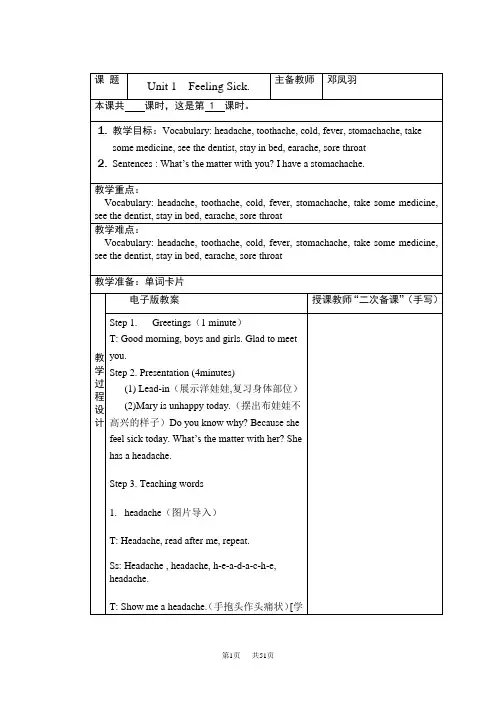
Step 3.Practice
1. Listen to the tape:P39 Practice1
And then check the answers
2. Do the exercise:workbook P23 practice2.
And then check the answers
(2)What’s the matter with you?
I have a cold.You should stay in bed.
(3)What’s the matter with you?
I hurt my foot.Be careful next time.
教学反思:
What’s the matter with
教学目标:The students can listen,say,read the conversation.
教学重点:The sentences.
教学难点:
Asking and givinging directions.
教学准备:单词卡片
教
教学过程设计
电子版教案
授课教师“二次备课”(手写)
Step1Warm up
电子版教案
授课教师“二次备课”(手写)
Step 1. Greetings(1 minute)
1. Show the pictures and review the words: headache,toothache,cold,fever,stomachache, earache,sore throat
教学难点:
Vocabulary:headache,toothache,cold,fever,stomachache,take some medicine,see the dentist,stay in bed,earache,sore throat
广东版 开心学英语六年级上册 Unit 1 A parade day 教案
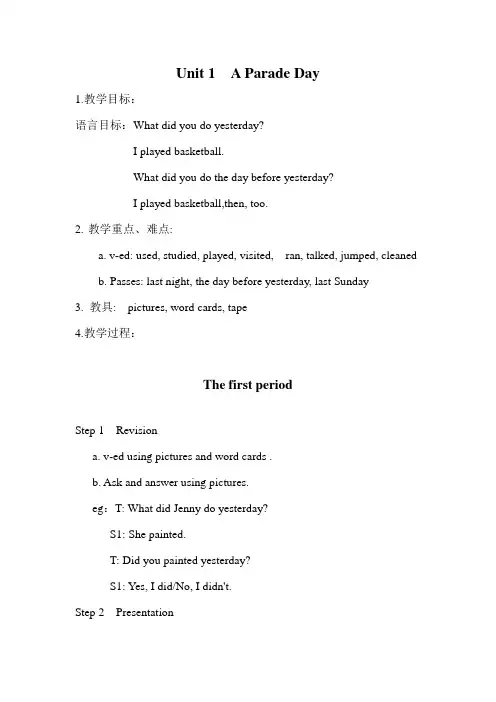
Unit 1 A Parade Day1.教学目标:语言目标:What did you do yesterday?I played basketball.What did you do the day before yesterday?I played basketball,then, too.2.教学重点、难点:a. v-ed: used, studied, played, visited, ran, talked, jumped, cleanedb. Passes: last night, the day before yesterday, last Sunday3. 教具: pictures, word cards, tape4.教学过程:The first periodStep 1 Revisiona. v-ed using pictures and word cards .b. Ask and answer using pictures.eg:T: What did Jenny do yesterday?S1: She painted.T: Did you painted yesterday?S1: Yes, I did/No, I didn't.Step 2 Presentationa. Ask and answer using pictures.T: Tom, what did you do yesterday?S2: I played watched TV.T: What about you, Peter?S3: I watched TV, too.T: Mary, what did you do yesterday?S4: I basketball/football.T: What did you do the day before yesterday? (Repeat.)S4: I played basketball/football, too.T: You can say, "I played basketball/football, of course." (Repeat.)(Write "the day before yesterday" , " of course" and sentences on the blackboard.)b. Teach "last night" and "last Sunday" in the same way.c. Teach v. and v-ed with word cards, pictures.eg. T: What did you do the day before yesterday?S5: I practiced piano. What about you, Miss Chen?T : I visited my good friend.(Repeat.)(Write these two pairs of v. and v-ed on the Bb. And ask the students to read them one by one. Tell them how to pronounce and the ways of the sounds. Teach other words in the same way.)Step3 Listen and repeat.Step4 Practice in pairs .Read v-ed and make sentences using them.Step5 Ask answer and write.Step6 Ask and answer.Step7 Summary.Step8 Homework.a. Try to recite Target.b. Remember v. and v-ed.Blackboard writing:Unit 1 A Parade Dayuse-used play-playedWhat did you do yesterday/last night/Sunday?run-ran study-studied I played basketball.talk-talked visit-visitedWhat did you do the day before yesterday?jump-jumped clean-cleaned I played basketball,then, too.5、教学反思:本节课是这个学期新授的第一节课,课本中出现的单词原形都属于以前学过的,但是还是出现大部分学生遗忘的情况,本单元主要围绕动词过去式的变化来学习单词,在新授过程中反复提起动词的含义以及动词的发音规则、变化规则,加强学生记忆。
UnitReview广东版开心英语上册教案
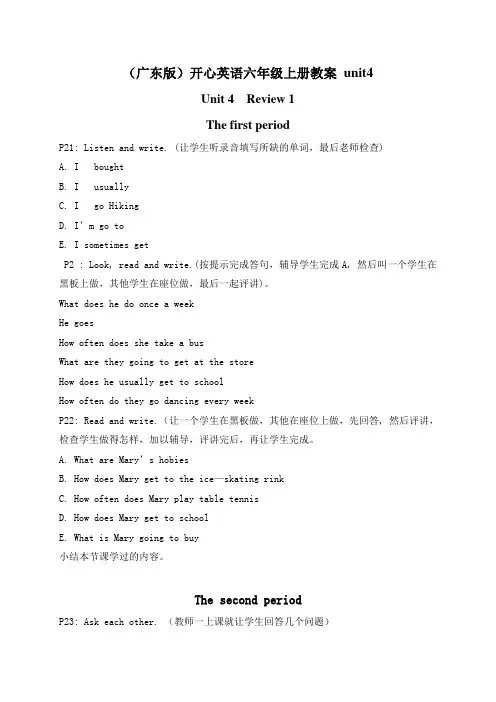
(广东版)开心英语六年级上册教案unit4Unit 4 Review 1The first periodP21: Listen and write. (让学生听录音填写所缺的单词,最后老师检查)A. I boughtB. I usuallyC. I go HikingD. I’m go toE. I sometimes getP2 : Look, read and write.(按提示完成答句,辅导学生完成A, 然后叫一个学生在黑板上做,其他学生在座位做,最后一起评讲)。
What does he do once a weekHe goesHow often does she take a busWhat are they going to get at the storeHow does he usually get to schoolHow often do they go dancing every weekP22: Read and write.(让一个学生在黑板做,其他在座位上做,先回答, 然后评讲,检查学生做得怎样,加以辅导,评讲完后,再让学生完成。
A. What are Mary’s hobiesB. How does Mary get to the ice—skating rinkC. How often does Mary play table tennisD. How does Mary get to schoolE. What is Mary going to buy小结本节课学过的内容。
The second periodP23: Ask each other. (教师一上课就让学生回答几个问题)How often do you play computer gamesHow often do you watch TVHow often do you go shoppingP23: Fill the chant. (辅导学生理解表格的内容,然后让学生自由采访,最后老师拿啊一个学生的答案按一起评讲)P24: Write a report. (老师辅导学生理解范文,然后给5分钟学生自由语言操练,老师抽查,最后家庭作业笔试,写在书本)P22: Listen, read and circle.(让学生听录音划圈,老师检查)做 Wb的练习小结本课内容。
六年级上册英语教案-Unit 3 Staying Healthy 第三课时 广东开心英语

六年级上册英语教案-Unit 3 Staying Healthy 第三课时广东开心英语教学内容本课时为广东开心英语六年级上册Unit 3 Staying Healthy的第三课时,主要围绕“健康生活”的主题展开。
教学内容包括词汇学习、句型练习、听力训练、口语表达及健康生活习惯的培养。
学生将通过本课时的学习,了解并掌握如何用英语描述健康的生活方式和表达健康的重要性。
教学目标1. 知识与技能:使学生能够准确运用本课时所学的词汇和句型谈论健康生活,提高听说能力。
2. 过程与方法:通过情境创设、小组合作、任务驱动等教学方法,培养学生自主、合作、探究的学习能力。
3. 情感态度价值观:引导学生树立健康的生活观念,关注自身健康,培养良好的生活习惯。
教学难点1. 正确使用本课时所学的词汇和句型进行口语表达。
2. 听懂并准确获取关键信息,提高听力理解能力。
3. 培养学生运用英语解决实际问题的能力。
教具学具准备1. 教学课件2. 录音机及磁带3. 学生用书及练习册4. 黑板、粉笔5. 小组活动道具(如卡片、图片等)教学过程1. 导入:通过图片、歌曲等形式,复习已学过的与健康生活相关的词汇和句型,为新课的学习做好铺垫。
2. 新课呈现:利用教学课件,展示本课时所学词汇和句型,引导学生观察、模仿、跟读,确保学生正确掌握发音和用法。
3. 情境创设:创设真实的生活场景,让学生运用所学知识进行角色扮演,提高口语表达能力。
4. 小组合作:学生分组进行讨论,分享各自的健康生活经验,培养合作精神和团队意识。
5. 任务驱动:布置任务,让学生运用所学知识完成相关练习,巩固所学内容。
6. 听力训练:播放录音,让学生听懂并准确获取关键信息,提高听力理解能力。
7. 总结与反馈:教师对本课时所学内容进行总结,学生进行自我评价和反馈,教师给予指导和鼓励。
板书设计板书设计应简洁明了,突出本课时所学重点,包括词汇、句型、语法等,方便学生复习和回顾。
作业设计1. 听力练习:完成练习册上的听力题目,提高听力理解能力。
广东版开心英语六年级上册全册教案
广东版开心英语六年级(上)全册教案Unit1 I wrote a long letter.一教学目标1.学会VOCABULARY 的单词。
2.复习巩固上学期学习的句型:“Did you…” 、“Yes, I did./No, I didn’t”、“Whatare you going to do? I’m going to...”、“I’ll…”3.懂得“air”、“ear”、“ere”在单词中的发音。
二教学重点1 掌握“air”、“ear”、“ere”的正确读法和发音。
2 熟练运用句式“Did you…”、“I’ll…”进行交际。
三教学难点1熟练运用句式“I’ll…”进行交际。
四. 教学用具教学录音带自制课件学生自备的信封、邮票、课文中单词的实物五教学过程THE FRIST PERIOD(Vocabulary、Review、Practic1、Practic2)1.revision :●Say hello to the students●Sing a song which they have learned in last term .2.Presentation:●Present the pictures of candy ice cream…with computer .●Write down the Chinese 糖、雪糕……●Have students to work out the number-plus-classifier●Take out all the objects and elicit all the nouns.3.Practice(1) :●Play a game and master the new words●Line up a list of “a” ,have Ss work out the English word of classifier, thenlearn the new words together.●Games: Make friends (match the number-plus-classifier and the nountogether.)4.Practice(2) :●T ask Ss a question and elicit Review.●Listen to the tape●Read together●Redesign the dialogue●Feedback5.Conclusion:Go over the blackboard writing .6 .Homework :●Copy the new words four for each .●Read the text to their parentsTHE SECOND PERIOD(Conversation、Chant activity1-2、Activity)1.revision :●Say hello to the students●Listening test.2.Presentation:●T tell a story about Tony and Gogo, and demonstrate how can Tony senda letter. As to elicit all the new knowledge points.4.Practice :●Listen to the tape and try to tell the story .●Listen and repeat.●Read together●Group work as to act out the dialogue●Listen to Chant activity and sing together.●Finish the Exercises on Page6.●Comes to Activity on Page74.Conclusion:Go over the blackboard writing .5.Homework :●Read the text to their parents●Imitate the essay on page7 and rewrite a new one.THE THIRD PERIOD(Sounds and words、Listen and chant、workbook)1.revision :●Say hello to the students●Chant together as warm up.2.Presentation:●Listen to the tape and find out what the features are .●T demonstrate how to pronounce “air” 、“ear”、“ere”.●Ss read it one by one .●Ss read the words freely, secondly ask them to set up more examples .3.Practice :●Listen to the tape and chant together .●Group work then make performance .4.Conclusion:Go over the blackboard writing .5.Homework :●Copy the words of “The sounds and words” (4 for each)●Read the text to their parentsUnit 2 I usually look for cookies.The first periodTeaching contents:V ocabulary and TargetTeaching key points:New words: never sometimes usually always subway bus taxi bikeHow do you get to school? I usually take the bus.Do you ever take a taxi to school? No! I never take a taxi to school.Teaching aids: recorder tape pictureTeaching procedure:一、T: How do you get to school?S: I walk get to school.(引导学生理解用usually的含义)T: I usually get to school.二、利用卡片引导学生学习新的单词①I never take a bus to school.I sometimes take a taxi to school.I always ride a bike to school.从句子中学习单词的意思(引导学生学习词组:take a taxi \take a bus\ ride a bike \take a subway)②板书句子:How do you get to school?I usually take the bus.③Read together and group by group④互相问答------进行小组中抽查掌握的情况。
粤人版开心学英语三年级起点小学六年级英语上册全套教案
Unit 1 Feeling Sick【教学目标】1.确保学生认识和理解一些基本单词的意义和简单口头运用。
2.需要掌握的词组:have a cold, have a fever, 等八个词组。
3.学习使用本课重点句型:(1)What's the matter with you?(2)I have a cold. You should stay in bed.(3)What's wrong with you?4.鼓励学生大胆发言及表达。
5.培养学生对英文学科的兴趣。
6.增强学生听说读写译的能力。
【教学重点】在学习了单词的基础上,以单词为载体,进行主要句型的学习,并了解其中的语法现象,根据具体情境,学会交流对话,侧重句型语法学习,交际意向和课外拓展为重点。
【教学难点】学生处于小学阶段,对英语有了初步了解,词汇储备较少,对于学生的要求难点是在会读,会说的基础上,能掌握一些基本单词的拼写和造句,了解一定的语法内涵,与人进行简单沟通交流。
【教学方法】1.音频,情景教学法。
2.Pair-work两人小组活动,Group-work小组活动,多媒体辅助教学。
【教学准备】课件、图片素材、音频文件、教学道具。
【教学过程】Step 1.Greeting.教师和学生之间,进行日常口语问候,例如:天气,星期,心情等。
Step 2.Warm-up/Leading.教师通过多媒体教学课件,播放和本次主题有关的图片。
(1)你如何向别人表达你身体的不舒适。
(2)自主探究:What's the matter with you?What's wrong with you?Step 3.Presentation.1.Words Learning.(1)老师放映课件,用中文询问同学看到了什么?同学们会看到课件上呈现的图画。
(2)教师拿出单词卡片,进入重点新词汇学习环节,向同学展示图片,结合PPT上放映的内容,带领同学学习一些新单词。
六年级上册英语教案-Unit 1 Feeling Sick 广东开心英语(粤人版)
六年级上册英语教案-Unit 1 Feeling Sick 广东开心英语(粤人版)教学内容本节课是广东开心英语六年级上册的第一单元,主题为“Feeling Sick”。
教学内容主要围绕描述身体不适、询问健康状况和提供帮助的日常英语表达。
通过学习本单元,学生能够掌握表达身体不适的基本词汇和句型,如“headache, stomachache, fever”等,并能进行简单的对话交流。
教学目标1. 知识目标:学生能够听懂、会说、会读本单元的关键词汇和句型。
2. 技能目标:学生能够在实际情境中运用所学英语进行关于健康状况的交流。
3. 情感目标:培养学生对健康问题的关注,提高他们的自我管理能力。
教学难点1. 正确运用本单元的词汇和句型描述身体不适。
2. 自然流畅地进行关于健康状况的对话。
教具学具准备1. 教学课件2. 录音机及录音带3. 学生用书及练习册4. 词汇卡片5. 图片或实物展示健康状况教学过程第一阶段:导入- 利用图片或实物展示不同的健康状况,引导学生复习已知的描述身体不适的词汇。
- 提问:“How are you feeling today?”,让学生尝试回答。
第二阶段:新授- 通过课件展示本单元的关键词汇和句型,如“headache, stomachache, fever”和“I have a headache.”等。
- 引导学生模仿并练习发音,确保他们能够正确朗读。
- 进行小组活动,让学生互相询问健康状况并回答。
第三阶段:实践- 设计角色扮演活动,让学生在模拟的医疗场景中练习使用本单元的句型和词汇。
- 教师巡回指导,及时纠正发音和用法错误。
第四阶段:巩固- 通过完成练习册上的相关练习,巩固学生对词汇和句型的掌握。
- 教师选取部分学生的作业进行点评和讲解。
第五阶段:总结- 回顾本节课所学内容,确保学生对关键知识点的理解和记忆。
- 鼓励学生在日常生活中运用所学英语描述健康状况。
板书设计1. 关键词汇:headache, stomachache, fever2. 句型:- “How are you feeling today?”- “I have a headache.”作业设计1. 完成练习册上的相关练习。
六年级上册英语教案-Unit 6 Planting Trees 广东开心英语(粤人版)
六年级上册英语教案-Unit 6 Planting Trees 广东开心英语(粤人版)教学内容本单元主要围绕“Planting Trees”这一主题展开,教学内容包括认识不同种类的树木、学习如何种植树木、以及了解树木对环境的重要性。
通过本单元的学习,学生能够掌握相关的词汇和句型,并能就种植树木这一话题进行简单的交流。
教学目标1. 知识与技能:学生能够听懂、会说、会读本单元的重点词汇和句型,并能运用所学知识进行简单的交流。
2. 过程与方法:通过小组合作、任务驱动等教学方法,培养学生自主学习、合作学习的习惯,提高学生的英语实际运用能力。
3. 情感态度与价值观:培养学生热爱大自然、关注环保的意识,激发学生保护环境的责任感。
教学难点1. 学生对树木种类及种植方法的认知。
2. 学生对树木对环境重要性的理解。
3. 学生在实际交流中正确运用本单元所学词汇和句型。
教具学具准备1. 多媒体课件。
2. 教学卡片。
3. 录音机及录音带。
4. 学生活动手册。
5. 植物种子、花盆、泥土等种植材料。
教学过程第一课时:导入与新课内容学习1. 导入:通过播放与树木相关的歌曲或视频,引起学生对本单元话题的兴趣。
2. 新课内容学习:教师引导学生学习本单元的重点词汇和句型,并通过图片、实物等教学辅助手段帮助学生理解和记忆。
第二课时:巩固与实际运用1. 巩固:通过游戏、角色扮演等活动,帮助学生巩固所学知识。
2. 实际运用:学生分组进行种植树木的实践活动,运用所学知识进行交流。
第三课时:总结与作业布置1. 总结:教师引导学生对本单元所学内容进行总结,并进行课堂评价。
2. 作业布置:布置与种植树木相关的作业,如制作植物观察日记、设计环保宣传海报等。
板书设计板书设计应简洁明了,突出本单元的重点词汇和句型。
可以采用思维导图、表格等形式,帮助学生更好地理解和记忆。
作业设计1. 制作植物观察日记:学生选择一种植物进行种植,记录植物的生长过程,并运用所学知识进行描述。
- 1、下载文档前请自行甄别文档内容的完整性,平台不提供额外的编辑、内容补充、找答案等附加服务。
- 2、"仅部分预览"的文档,不可在线预览部分如存在完整性等问题,可反馈申请退款(可完整预览的文档不适用该条件!)。
- 3、如文档侵犯您的权益,请联系客服反馈,我们会尽快为您处理(人工客服工作时间:9:00-18:30)。
广东版开心英语六年级(上)全册教案Unit1 I wrote a long letter.一教学目标1.学会VOCABULARY 的单词。
2.复习巩固上学期学习的句型:“Did you…” 、“Yes, I did./No, I didn’t”、“Whatare you going to do? I’m going to...”、“I’ll…”3.懂得“air”、“ear”、“ere”在单词中的发音。
二教学重点1 掌握“air”、“ear”、“ere”的正确读法和发音。
2 熟练运用句式“Did you…”、“I’ll…”进行交际。
三教学难点1熟练运用句式“I’ll…”进行交际。
四. 教学用具教学录音带自制课件学生自备的信封、邮票、课文中单词的实物五教学过程THE FRIST PERIOD(Vocabulary、Review、Practic1、Practic2)1.revision :●Say hello to the students●Sing a song which they have learned in last term .2.Presentation:●Present the pictures of candy ice cream…with computer .●Write down the Chinese 糖、雪糕……●Have students to work out the number-plus-classifier●Take out all the objects and elicit all the nouns.3.Practice(1) :●Play a game and master the new words●Line up a list of “a” ,have Ss work out the English word of classifier, thenlearn the new words together.●Games: Make friends (match the number-plus-classifier and the nountogether.)4.Practice(2) :●T ask Ss a question and elicit Review.●Listen to the tape●Read together●Redesign the dialogue●Feedback5.Conclusion:Go over the blackboard writing .6 .Homework :●Copy the new words four for each .●Read the text to their parentsTHE SECOND PERIOD(Conversation、Chant activity1-2、Activity)1.revision :●Say hello to the students●Listening test.2.Presentation:●T tell a story about Tony and Gogo, and demonstrate how can Tony senda letter. As to elicit all the new knowledge points.4.Practice :●Listen to the tape and try to tell the story .●Listen and repeat.●Read together●Group work as to act out the dialogue●Listen to Chant activity and sing together.●Finish the Exercises on Page6.●Comes to Activity on Page74.Conclusion:Go over the blackboard writing .5.Homework :●Read the text to their parents●Imitate the essay on page7 and rewrite a new one.THE THIRD PERIOD(Sounds and words、Listen and chant、workbook)1.revision :●Say hello to the students●Chant together as warm up.2.Presentation:●Listen to the tape and find out what the features are .●T demonstrate how to pronounce “air” 、“ear”、“ere”.●Ss read it one by one .●Ss read the words freely, secondly ask them to set up more examples .3.Practice :●Listen to the tape and chant together .●Group work then make performance .4.Conclusion:Go over the blackboard writing .5.Homework :●Copy the words of “The sounds and words” (4 for each)●Read the text to their parentsUnit 2 I usually look for cookies.The first periodTeaching contents:V ocabulary and TargetTeaching key points:New words: never sometimes usually always subway bus taxi bikeHow do you get to school? I usually take the bus.Do you ever take a taxi to school? No! I never take a taxi to school.Teaching aids: recorder tape pictureTeaching procedure:一、T: How do you get to school?S: I walk get to school.(引导学生理解用usually的含义)T: I usually get to school.二、利用卡片引导学生学习新的单词①I never take a bus to school.I sometimes take a taxi to school.I always ride a bike to school.从句子中学习单词的意思(引导学生学习词组:take a taxi \take a bus\ ride a bike \take a subway)②板书句子:How do you get to school?I usually take the bus.③Read together and group by group④互相问答------进行小组中抽查掌握的情况。
⑤T: How does she get to school?S: She usually takes a bus to school.T: Do you ever take a taxi to school?S: No ! I never take a taxi to school.⑥Practice 1\ 2 (Page 11)三、要求学生能把其背出来。
四、Do exercise: Look and writewalk五、Copy the new words and sentences.Rev ise the Target五:板书设计:How do you get to school? I usually take a bus.……does she/he………? She/He…………..The second periodTeaching contents:ConversationTeaching key points:New words: insects look for find of course lost foundI usually look for cookies. We’re lost.Teaching aids: recorder tape pictureTeaching procedure:一、先放一篇课文读一次,后让学生理解课文的内容,引导其把不懂的说出来。
二、重点教学生单词:find ---found insects look for⑴每一幅图抽学生将他读一次。
⑵叫学生表演Gogo Tony Jenny⑶互相背书和小组间互相检查。
⑷唱歌---让学生边听歌边Finish the sentences.(5)Activity ----Draw, ask and answer⑹Do exercise : Writing Book Unit 2⑺Homework:Copy conversation and revise it.The third periodTeaching contents:Sounds and wordsTeaching key points:New words: ear hear near clear cheer beerTeaching aids: recorder tape pictureTeaching procedure:一、教师将ear 的音标写出来,让学生看着书本上的相同字母,把字母同一音标的圈出来。
二、播放录音,让学生跟读。
三、学生通过充分练习后,教师发一个音,让学生指着相应的单词,游戏是看嘴猜单词。
四、玩游戏,小组间互相点和读。
五、小练习:完成填空题。
六、Let’s listen to the chant. 播放一次录音,全班跟着唱。
七、Homework:Copy the words and Listen chant.Unit 3 How often do you go hiking?The first period(V ocabulary & Target)Teaching objectives:1、学习V ocabulary部分的单词和词组,要求四会。
